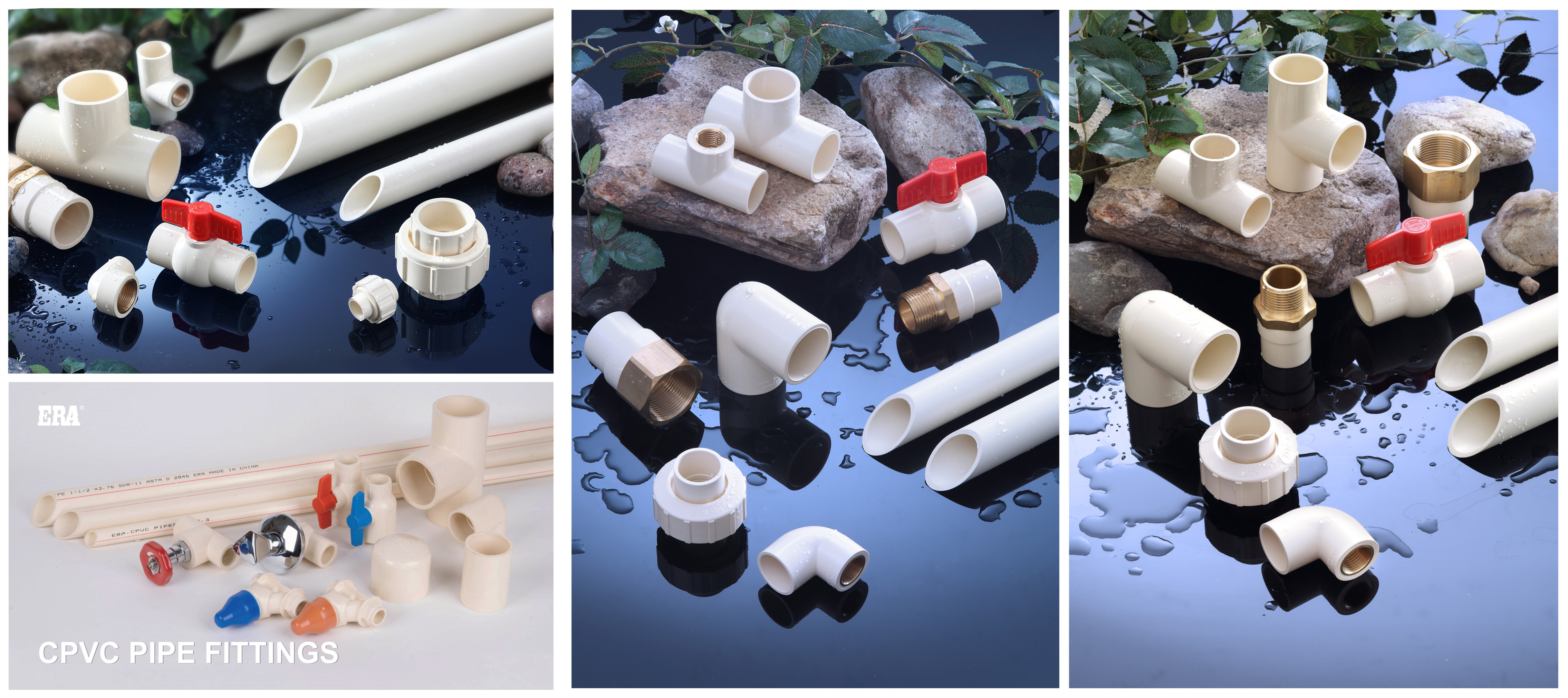









What is cpvc?
CPVC stands for Chlorinated Polyvinyl Chloride. It is a type of thermoplastic material made by chlorinating PVC (Polyvinyl Chloride) resin. The chlorination process enhances the material's heat resistance and overall performance, making CPVC suitable for a wide range of applications, particularly those involving hot water and higher temperature environments.
CPVC is a rigid,thermoplastic pipe and fitting material approved for potable water distribution throughout the World.CPVC pipe is joined to CPVC fittings with solvent cement and requires only inexpensive, readily available,and easy-to-use tools.
CPVC Raw Material Advantages
CPVC has been used successfully in residential,commercial, and industrial applications for over 50 years. Its most common application is in single-family and multifamily hot and cold water distribution systems. CPVC can also be used for residential fire sprinkler systems, gray water systems, reclaimed water,chemical drain waste systems,industrial processing, and commercial and high-rise construction.The key advantages of CPVC are its low cost,resistance to corrosion, pitting, and scaling, its ease of installation, and its light weight.
Excellent Chemical Resistance
ERA CPVC pipe and fittings are chemically inert to most mineral acids, bases and salts, as well as aliphatic hydrocarbons. In addition, these systems are not subject to galvanic corrosion.

Superior Mechanical Properties
Comparing with other engineering thermoplastic such as PVC,ABS,PP and PPR, ERA CPVC Pipe and fittings has the maximum working pressure and support spacing. It provides the user with the superior operating range and design space, and its expected life for pressuring service is up to 50years or more, which much better than other thermoplastic material.
What is ERA CPVC?
ERA CPVC Pipes and fittings are made of high performance CPVC material. Its physical and chemical properties make ERA a versatile piping system in a wide rang of applications indifferent industries.
ERA have various standard of CPVC pipes and fittings which fulfill most demands from allover the world. Till now,ERA has CPVC CTS Pipe fittings (ASTMD 2846), CPVC SCH80 Pipe fittings, CPVC DIN Pipe fittings, CPVC NBR15884 pipe fittings, CPVC Valves suitable for DIN,SCH80,BS,JIs...
https://youtu.be/EiTCwyFbJr0?si=dVwpszXzGmYXurUA
What is the advantages of ERA CPVC?

Whats the features and Benefits of ERA CPVC PIPE FITTINGS?

Most suitable for carrying drinking water:
Retards bacterial growth, which keeps the water quality healthy and very good.They are suitable even for aggressive water pH levels of less than 6.5.CPVC Pipes meant for carrying water should have NSF certification according to ANSI/NSF Standard61/ program policy 45 (RVCM levels in these pipes are so low as to be undetectable).
Hot and cold water compatible:
CPVC Pipe is compatible with both hot and cold water. It withstands very high temperature compared to any other thermoplastic plumbing systems.Many solar and electric water heaters have CPVC piping systems for heat efficiency and lower installation cost.
Low Thermal Expansion:
CPVC Pipes has a lower coefficient of thermal expansion than alternative plastics, reducing the amount that the pipe expands when hot water is running, again reducing unsightly looping of the pipe.
Completely leak proof:
The cold welding using CPVC solvent is fast and simple, ensuring leak free installation for the entire life span of the piping system.
Superior Insulation:
CPVC pipe is more energy efficient than other alternative pipes.As an insulator it does not lose heat the way other pipes do.Heat loss and thermal expansion are reduced.
Strength:
CPVC Pipe is a highly resilient, though and durable product that has tensile strength and high impact strength. It will withstand at high pressure and temperature for long periods.
Fire Safety:
CPVC has a limiting Oxygen lndex (LOl) of 60.Thus in air, CPVC pipe does not support combustion. No flaming drips, does not increase the fire load , low flame spread , low smoke generation.
Easy, cold welding process:
CPVC uses a simple, solvent cement jointing method.Tools required are very simple and inexpensive (Deburring / Beveling tool and pipe cutter only) and avoid the need for an electrical source.
Fire Safety:
CPVC has a limiting Oxygen lndex (LOl) of 60.Thus in air, CPVC pipe does not support combustion. No flaming drips, does not increase the fire load , low flame spread , low smoke generation.
Easy, cold welding process:
CPVC uses a simple, solvent cement jointing method.Tools required are very simple and inexpensive (Deburring / Beveling tool and pipe cutter only) and avoid the need for an electrical source.

CPVC shares some similarities with PVC but has distinct characteristics due to the chlorination process. Some key features of CPVC include:
Temperature Resistance:
CPVC can withstand higher temperatures than standard PVC. It is capable of handling hot water and fluids at temperatures up to 93°C (200°F) without deformation or degradation.
Pressure Resistance:
CPVC pipes and fittings are designed to handle higher pressure levels, making them suitable for plumbing systems that require enhanced strength.
Chemical Resistance:
CPVC exhibits good resistance to many chemicals, acids, and alkalis, making it suitable for transporting a variety of fluids.
Fire Resistance:
CPVC is inherently fire-resistant and has a low flame spread rating, making it a safer choice for certain applications.
Corrosion Resistance:
CPVC is resistant to corrosion, adding to its durability and suitability for use in various environments.
Electrical Insulation:
CPVC has relatively good electrical insulation properties.

Due to its unique combination of properties, CPVC is commonly used in applications such as hot and cold water plumbing systems, industrial processing, fire sprinkler systems, and more. It provides a reliable and durable solution for fluid transport and plumbing needs, especially in situations where higher temperatures or pressure levels are involved.
